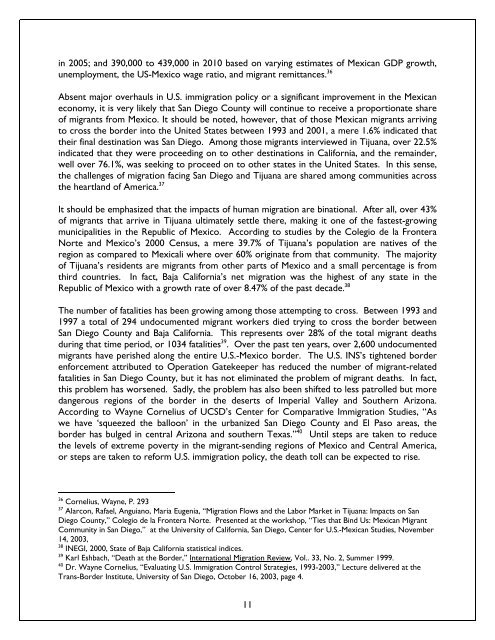Blurred Borders - International Community Foundation
Blurred Borders - International Community Foundation
Blurred Borders - International Community Foundation
You also want an ePaper? Increase the reach of your titles
YUMPU automatically turns print PDFs into web optimized ePapers that Google loves.
in 2005; and 390,000 to 439,000 in 2010 based on varying estimates of Mexican GDP growth,<br />
unemployment, the US-Mexico wage ratio, and migrant remittances. 36<br />
Absent major overhauls in U.S. immigration policy or a significant improvement in the Mexican<br />
economy, it is very likely that San Diego County will continue to receive a proportionate share<br />
of migrants from Mexico. It should be noted, however, that of those Mexican migrants arriving<br />
to cross the border into the United States between 1993 and 2001, a mere 1.6% indicated that<br />
their final destination was San Diego. Among those migrants interviewed in Tijuana, over 22.5%<br />
indicated that they were proceeding on to other destinations in California, and the remainder,<br />
well over 76.1%, was seeking to proceed on to other states in the United States. In this sense,<br />
the challenges of migration facing San Diego and Tijuana are shared among communities across<br />
the heartland of America. 37<br />
It should be emphasized that the impacts of human migration are binational. After all, over 43%<br />
of migrants that arrive in Tijuana ultimately settle there, making it one of the fastest-growing<br />
municipalities in the Republic of Mexico. According to studies by the Colegio de la Frontera<br />
Norte and Mexico’s 2000 Census, a mere 39.7% of Tijuana’s population are natives of the<br />
region as compared to Mexicali where over 60% originate from that community. The majority<br />
of Tijuana’s residents are migrants from other parts of Mexico and a small percentage is from<br />
third countries. In fact, Baja California’s net migration was the highest of any state in the<br />
Republic of Mexico with a growth rate of over 8.47% of the past decade. 38<br />
The number of fatalities has been growing among those attempting to cross. Between 1993 and<br />
1997 a total of 294 undocumented migrant workers died trying to cross the border between<br />
San Diego County and Baja California. This represents over 28% of the total migrant deaths<br />
during that time period, or 1034 fatalities 39 . Over the past ten years, over 2,600 undocumented<br />
migrants have perished along the entire U.S.-Mexico border. The U.S. INS’s tightened border<br />
enforcement attributed to Operation Gatekeeper has reduced the number of migrant-related<br />
fatalities in San Diego County, but it has not eliminated the problem of migrant deaths. In fact,<br />
this problem has worsened. Sadly, the problem has also been shifted to less patrolled but more<br />
dangerous regions of the border in the deserts of Imperial Valley and Southern Arizona.<br />
According to Wayne Cornelius of UCSD’s Center for Comparative Immigration Studies, “As<br />
we have ‘squeezed the balloon’ in the urbanized San Diego County and El Paso areas, the<br />
border has bulged in central Arizona and southern Texas.” 40 Until steps are taken to reduce<br />
the levels of extreme poverty in the migrant-sending regions of Mexico and Central America,<br />
or steps are taken to reform U.S. immigration policy, the death toll can be expected to rise.<br />
36 Cornelius, Wayne, P. 293<br />
37 Alarcon, Rafael, Anguiano, Maria Eugenia, “Migration Flows and the Labor Market in Tijuana: Impacts on San<br />
Diego County,” Colegio de la Frontera Norte. Presented at the workshop, “Ties that Bind Us: Mexican Migrant<br />
<strong>Community</strong> in San Diego,” at the University of California, San Diego, Center for U.S.-Mexican Studies, November<br />
14, 2003,<br />
38 INEGI, 2000, State of Baja California statistical indices.<br />
39 Karl Eshbach, “Death at the Border,” <strong>International</strong> Migration Review, Vol.. 33, No. 2, Summer 1999.<br />
40 Dr. Wayne Cornelius, “Evaluating U.S. Immigration Control Strategies, 1993-2003,” Lecture delivered at the<br />
Trans-Border Institute, University of San Diego, October 16, 2003, page 4.<br />
11















